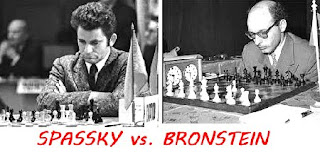Wade was New Zealander who emigrated to England because of the greater opportunities to play chess there. In the book, Wade is in agreement with Kotov and Yudovich when in the Soviet School of Chess they claimed Soviet players were the best in the world. See the tribute to Wade HERE.
In this book there are 120 games (in Descriptive Notation) and it's divided into sections: Beginnings, World Championship Contenders, Soviet Champions, Modern Composers, Women Players, World Correspondence Champions, Early Soviet Champions and there is an appendix of tournament crosstables.
The 27th USSR Championship was held at the Chigorin Chess Club in Leningrad from January 26th to February 26th, 1960. Twenty of the Soviet Union's best GMs and masters participated in the event. Tal was absent because of his preparation for the coming world championship match with Botvinnik.
The tournament was the first of four wins for Viktor Korchnoi. Here he dominated the field, but only edged out Efim Geller and Tigran Petrosian by half a point at the end with a stellar three win streak in the final rounds.
This tournament also saw the famous King's Gambit game between Boris Spassky and David Bronstein in the sixteenth round that would later be featured in the James Bond film, From Russia With Love and it is the one featured here.
It was with good reason that Bobby Fischer was ecstatic about Spassky’s play when he saw the game! For more information on this famous game visit HERE.
Because so few of the of over 1,000 visitors since I posted the test game viewer indicated a preference, I am going to continue experimenting with Aquarium. Remember, in order to see all the annotations you have to move the slider bar and the board will automatically follow.
Boris Spassky - David Bronstein
Leningrad 1960.02.20
King's Gambit Accepted
[...] 1.e4 e5 2.f4 exf4 3.♘f3 d5 Rarely played but it has given good results for black. Usual is 3...g5. 4.exd5 ♗d6 Another unusual move. aimed at holding the P. Usual is 4...Nf6. 5.♘c3 In this position white has tried 5.Bb5+ and 5.Bc4 but Spassky's move seems best. 5...♘e7 Played with the possibility of holding onto the P by ...Ng3. In the Auerbach-Duras game in the Abbazia gambit tournament in 1912 black played 5... Nf6 after which the best way for white to continue would have been 6.Bb5+ leading to an exchange of Qs, but playing the K-Gambit without Qs would have been unthinkable back in those days. 6.d4 O-O 7.♗d3 ♘d7 8.O-O h6 Played because he disliked the possibility of Ng5 by white, but Spassky's recommendation of 8...Nf6 was better. 9.♘e4 Very good! White sacrifices a P to increase the activity of his pieces. 9...♘xd5 10.c4 ♘e3 11.♗xe3 fxe3 One might be tempted to play 12.Nxd6 here gaining the two Bs and leaving black with weak Ps, but Spassky's idea is to drive back black's pieces and set up a B and Q battery on the b1-h7 diagonal. 12.c5 Impressive! 12...♗e7 13.♗c2 ♖e8
13...f5 None of the annotators have mentioned this move which only an engine would dare play. 14.♘g3 g6 15.♕d3 ♔h7 16.♕xe3 ♘f6 and black has adequate defensive resources.
14.♕d3 These days one has to be careful in blindly following engine opening books because my Fritz book gives Bronstein's next move (designed to deflect white's Q off the diagonal), but it's a serious mistake. After his next move Bronstein had left himself with only 20 minutes for 26 moves, so he is already in serious time pressure. 14...e2 When annotating this game Ilya Kan remarked that Rubinstein or Capa would have played 15,Rf2, but Spassky weighed the pros and cons of his next move while admitting that he got a little carried away.
14...f5 was still the best. 15.♕c4 ♔h8 16.♘g3 g6 leaving white with a number of interesting possibilities, one of which is 17.c6?! 17.c6
15.♘d6 Andy Soltis called this one of the deepest sacrifices this side of The Evergreen Game...Spassky ignores his R and threatens to sacricie on f7. Of course there was nothing wrong with keeping a significant advantage with 15.Qxe2. 15...♘f8 After this black is lost.
15...exf1=♕ After this the following moves are forced... 16.♖xf1 ♗xd6 17.♕h7 ♔f8 18.cxd6 cxd6 19.♕h8 ♔e7 20.♖e1 ♘e5 21.♕xg7 with a double edged position after either 21...Be6 or 21...Rg8 21...♗e6 (21...♖g8 22.♕xh6 ♗e6 23.dxe5 dxe5) 22.dxe5 dxe5 23.♘xe5
15...♗xd6 Was Spassky's recommendation, but it leads to noe more than equality after 16.♕h7 ♔f8 17.cxd6 exf1=♕ 18.♖xf1 cxd6 19.♕h8 ♔e7 20.♖e1 ♘e5 21.♕xg7 reaching the same position as after 15...exf1Q+
16.♘xf7 Winning. 16...exf1=♕ 17.♖xf1 ♗f5
17...♔xf7 and now white has a mate in 6 with three different moves! 18.Ne5+, 18.Bb3 and 18.Ng5+ 18.♘e5 ♔g8 19.♕h7 Very pretty! 19...♘xh7 20.♗b3 ♕d5 21.♗xd5 ♗e6 22.♗xe6 ♔h8 23.♘g6#
(17...♕d5 fails after 18.♘xh6 gxh6 19.♗b3 winning the Q) 18.♕xf5 ♕d7 19.♕f4 ♗f6 20.♘3e5 ♕e7
20...♗xe5 Offered somewhat better chances. 21.♘xe5 ♖xe5 This is best. 22.dxe5 ♖e8 And black is only a P down but the ending is lost. This would have been a horribly boring ending to what has been a very exciting game!
21.♗b3 ♗xe5
21...♘e6 Blocking the B is wasn't any better. 22.♕g4 ♗g5 23.♘xg5 ♕xg5 24.♗xe6 ♖xe6 25.♕xe6 ♔h7 wins
22.♘xe5 ♔h7 White has a mate in 15 23.♕e4 Here the game ends whether by resignation or forfeit I am not sure.
23.♕e4 g6 24.♖xf8 ♕g7 25.♖f7 ♕xf7 26.♗xf7 ♖g8 27.♘xg6 ♔g7 28.♕e7 ♔h7 29.♗xg8 ♔xg8 30.♘f4 ♖f8 31.♘e6 ♖f7 32.♕e8 ♖f8 33.♕xf8 ♔h7 34.♕g7#
Powered by Aquarium



No comments:
Post a Comment